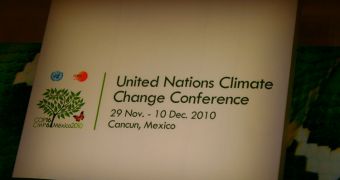The 2010 UN Climate Change Conference in Cancun, Mexico, kicked off on November 29, with 193 nations meeting to decide on successor to the Kyoto Protocol. Climate data provided by European Space Agency (ESA) satellites are being used as testimony to the seriousness of ongoing climate change.
In addition to developing a new form of the successful 1997 climate treaty, another main goal on the agenda of participating states is establishing an international climate monitoring system.
Reliable climate datasets are absolutely essential to decision-makers, if they are to develop suitable strategies of combating global warming and related changes that threaten to cause negative consequences at a global level.
The Subsidiary Body for Scientific and Technological Advice (SBSTA) is the main science group at the meeting, and its job is to provide the latest expert advices, information and relevant studies.
Over the past five years, coverage of aspects related to climate change has increased considerably, but experts underline the necessity of boosting these efforts in order to collect even more data.
The announcement was made in the plenary SBSTA session, which took place on Wednesday, by the Chairman of the Global Climate Observing System (GCOS) Steering Committee, Adrian Simmons.
He said that the recent progress is encouraging, but urged sustained efforts to ensure that scientific momentum and interest are not lost, ESA officials report.
The GCOS is responsible for providing comprehensive surveys and datasets to the UN Framework Convention on Climate Change (UNFCC). Space agencies around the world are collaborating with this body for creating the most thorough representation of what's going on with the planet.
The 2010 GCOS report shows that Earth-observing satellites such as the ones operated by NASA and ESA are starting to play a major role in climate sciences, revealing data that cannot be obtained during field surveys on the ground.
The space component of the Global Climate Observing System is carried out by the Committee on Earth Observation Satellites (CEOS), which includes most major space agencies.
Over the next ten years, ESA alone will develop, build and launch some 20 satellite dedicated specifically to analyzing temperature, aerosols, greenhouse gas emissions, pollution and the planet's natural cycles.
These new spacecraft will add to existing ones already in orbit, including GOCE, which analyzes variations in the planet's gravity pull, CRYOSAT, which looks at sea-ice thickness, and SMOS, which analyzes oceanic salinity and soil moisture.
All that is needed for a thorough survey of Earth is the political will to allot funds for this effort.

 14 DAY TRIAL //
14 DAY TRIAL //